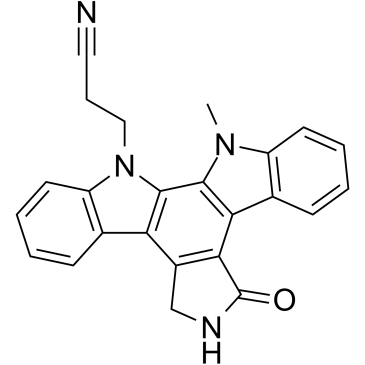| Description |
Go6976 is a Protein Kinase C (PKC) inhibitor, with an IC50 of 20 nM.
|
| Related Catalog |
|
| Target |
IC50: 20 nM (PKC)[1].
|
| In Vitro |
Go6976 is a potent inhibitor of PKC in vitro (IC50 is 20 nM. This compound is structurally related to staurosporine, which is the most potent PKC inhibitor[1]. UCN-01 is originally identified as a PKC inhibitor. Surprisingly, Go6976 is found to abrogate S and G2 arrest. Dose-response studies reveal that 30 nM Go6976 is sufficient to cause abrogation of S-phase arrest in 6 h and abrogation of G2 arrest followed by lethal mitosis in 24 h. Incubation of cells with 100 nM Go6976 is sufficient to cause complete abrogation of S and G2 arrest at 6 and 24 h, respectively, which is only slightly less potent than in bovine serum. Incubation of cells with UCN-01 or Go6976 alone do not decrease viability compared with control at the concentrations used. Incubation of cells with 5 ng/mL SN38 result in cytostasis, and addition of 50 nM UCN-01 or 100 nM Go6976 to arrested MDA-MB-231 cells cause a dramatic decrease in viable cell number by 96 h[2].
|
| Cell Assay |
Logarithmically growing cells are incubated with or without 5 ng/mL SN38 for 24 h and then incubated with or without 50 nM UCN-01 or 100 nM Go6976 for the following 24 h. MDA-MB-231 (500 cells) or MCF-10A (1000 cells) are plated in 100 μL in each well of a 96-well plate. The following day, drugs are added at the desired concentrations (Go6976: 1, 3, 10, 30, 100 nM) and with the required schedule to replicate wells (a minimum of 4 wells/concentration). Drugs are removed, and plates are rinsed and then incubated for an additional 6 days. Inhibition of growth was then assessed on the basis of DNA content. Briefly, the media are removed, and attached cells are washed in 0.25×PBS, followed by the addition of 100 μL of H2O. Cells are lysed by freeze/thawing the plates. Hoechst 33258 is added in high-salt buffer, cells are incubated for 2 h, and fluorescence is measured[2].
|
| References |
[1]. Qatsha KA, et al. Gö 6976, a selective inhibitor of protein kinase C, is a potent antagonist of human immunodeficiency virus 1 induction from latent/low-level-producing reservoir cells in vitro. Proc Natl Acad Sci U S A. 1993 May 15;90(10):4674-8. [2]. Hayamitsu Adachi, et al. Microbial metabolites and derivatives targeted at inflammation and bone diseases therapy: chemistry, biological activity and pharmacology. The Journal of Antibiotics volume 71, pages 60–71 (2018).
|
